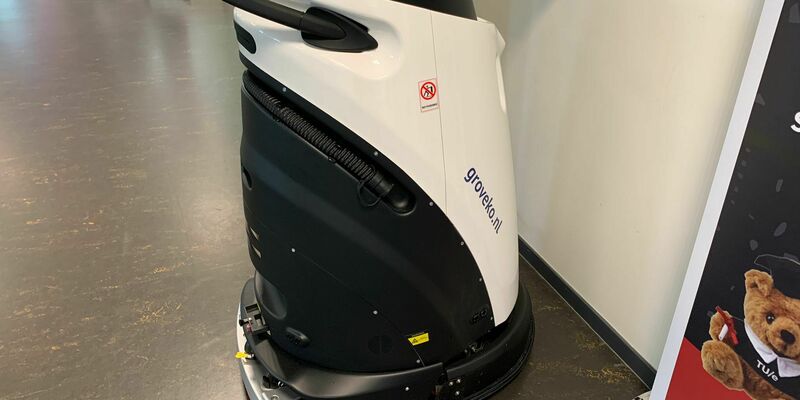
- Campus
- 13/06/2022
Asito tests cleaning robot at TU/e
A cleaning robot is a perfect fit for a technical university, so thought TU/e and Asito when they started the pilot project in MetaForum and Atlas. The automated cleaning companion certainly draws a lot of attention. “We see that it has to stop between forty and fifty times a day due to curious students, but that’s understandable”, says Tey van den Waardenburg, project leader at Asito.
The cleaning robot – unnamed as of yet – is attracting a lot of attention. “Especially in Atlas, people would stop and look”, says Bertie Fijneman. She is the Facility Services Coordinator and supervises the project from within TU/e. “The robot cleans the Atlas and MetaForum buildings and will also start cleaning the Student Sports Center as of next week. It’s a scrubber dryer: it mops and vacuums the floor.”
Van den Waardenburg: “We started the pilot in the week of May 30. In the mornings, the robot cleans the MetaForum and in the afternoons, after the break, it cleans floor 0 of the Atlas building. Those are large spaces and it takes a lot of time to keep the floors clean. The same goes for the SSC, where we’ll be testing the robot this week.”
The choice for these buildings was a logical one, says Fijneman. “We chose spaces with long walking distances, as the robot cleans most efficiently in such areas. It also starts very early in the morning because it’s quieter at that time, which makes it easier for the robot to clean, because it doesn’t have to swerve as much for people who get in its way.”
Eyeballs
A path has to be programmed for each floor that needs cleaning and the programming certainly requires some technical knowledge. Van den Waardenburg: “It’s quite a task that requires the help of a specialist; we can’t let our cleaners do it. However, we’re fortunate enough to have an employee in the team who’s extremely interested in robotics and has a background in technology. He really thinks of the robot as his baby.” After the robot’s first few working days, Asito has already spotted some areas for improvement. For example, little walls should be placed around the large chairs in the Atlas hall. That will make it easier to program the path and help the robot recognize its surroundings.
Van den Waardenburg has also noticed that the automated colleague attracts a lot of eyeballs. “Many students stop to watch it and step in its path to see how it responds. That’s clearly reflected in the data readout. In the first few days, it had to deviate from its path between forty and fifty times because of curious students, but that’s understandable. It does provide real added value for a technical university”, he believes. If people get in the way, the robot tries to clean that spot one more time afterwards. “After its working day, we can read the software and see exactly which areas it has or hasn’t cleaned. We can use these data to optimize the path.” Something that might pose a challenge to the robot is a loose cable, for example. “It won’t suck it up, but it might get stuck because of it. We also use these data to check whether it sucks up the water when it goes around corners, for example.”
More sustainable
The cleaning robot uses considerably less water than a traditional scrubber dryer. It has a separate filtration system that saves more than half of the water in Atlas. The system does not use chemical cleaners as standard, and it has a pump that constantly cleans the water. “Every once in a while, cleaning products are used during the cleaning process, but not on a standard basis”, the Asito project manager explains.
Chip shortage
Asito is currently testing the cleaning robots at ten different locations throughout the Netherlands. Fijneman: “The pilot is also interesting in view of the staff shortage; the robot could provide alleviation in this respect.” Still, do not expect to see robots replacing cleaning staff, Van den Waardenburg emphasizes: “It’s not our intention to use robots as a replacement for staff. After all, it can’t do nearly as much as a human being, nor can it make its own assessments, such as, for example, cleaning a particular section of the floor twice to remove heavy soiling.” Fijneman: “Cleaning staff will certainly remain necessary; the robot cannot clean offices with all kinds of furniture or toilets, for example.”
The current robot at TU/e is a test robot that Asito is using in other places as well to test the technology. Depending on whether it passes its trial period, it may be given a permanent position. “But getting a permanent robot is not that simple at the moment, even if we find it satisfactory”, says van den Waardenburg. “The global chip shortage complicates things. Not to mention the fact that the robots are very expensive. Also, we shouldn’t just assume at this point that it’ll save a lot of time, because we still need an employee to monitor it, fill it and clean it at the end of the day. But in the meantime, that employee now has the opportunity to do other things, so that’s a plus.”
“Should this trial prove successful, we might decide to use cleaning robots in several places on campus in the future”, says Van den Waardenburg. “However, we do have to consider the costs.” So what are those costs? “About as much as a luxury car. Retail prices are between 35,000 and 40,000 euros for the smallest model without accessories. It’s cheaper to hire an employee to clean the same surface area. And in most cases, the result is better too.”
Curious to learn more? Today, Cursor will watch as the robot is tested in the Student Sports Center. Videos can be found on our socials later today.
Discussion